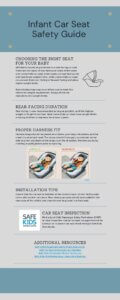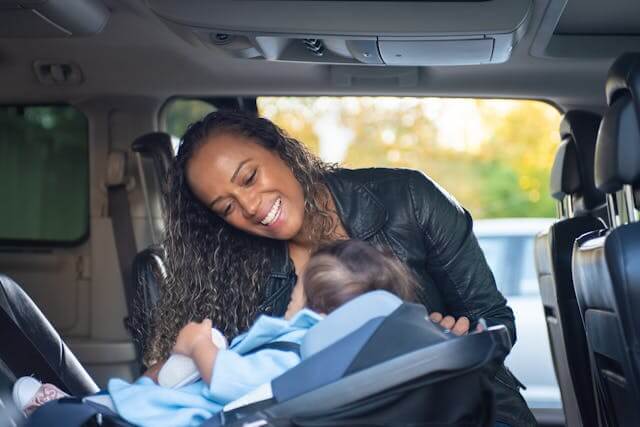As a parent, keeping your child safe is always a priority. When your baby takes their first ride home from the hospital, you want to make sure that they are safe in their car seat on the road.
Have you ever looked at a car seat manual before? They can be very long, tedious, and confusing. Not to mention, every car seat is different, and to further muddy the waters, there are seemingly endless options out there. Motor vehicle accidents are the leading cause of death in children 12 and under in the United States [1]. Proper car seat use reduces the risk of death by 28% and injury by 71 – 82% in car accidents [2] [4]. Researchers have found that around 70% of car seats are misused in general, but this number significantly increases among newborns. One study found that 95% of car seats were misused at hospital discharge [3]. These statistics can seem scary, but they highlight the significance of proper car seat use, especially in the event of an accident. So, how can you know that you’re choosing the right one and, most importantly, using it correctly? Thankfully, there are many resources out there to help you achieve these safety goals. The American Academy of Pediatrics (AAP) has guidelines to ensure that your little one is safely secured for all their future adventures in the car. Let’s break this down into a couple of sections: choosing the right seat for your baby, rear-facing duration, proper harness fit, installation tips, and car seat inspection.
Choosing the right seat for your baby:
The AAP states that all infants should be positioned in a rear-facing car seat. There are two types of rear-facing car seats: infant car seats and convertible car seats. Infant seats are rear-facing only and have lower weight limits, typically for both minimum and maximum weight. On the other hand, convertible car seats can convert from rear-facing to forward-facing and generally allow higher weight limits, both minimum and maximum. Smaller babies may require an infant seat to meet the minimum weight requirement, so it is important that you check the manufacturer’s weight limits for your car seat.
Rear-facing duration:
The AAP recommends that children remain rear-facing as long as possible, until the highest weight or height is reached. Most convertible car seats have weight limits allowing children to rear-face for at least 2 years. It is also important to check your state’s car seat laws, as many state laws require rear-facing until the age of 2.
Proper harness fit:
The harness straps should be positioned in the slots at or below your baby’s shoulders, and the chest clip should be centered and positioned at armpit-level. The straps should fit snugly; you should not be able to pinch any slack on the straps over the shoulders (often called the “pinch test”). Remove any bulky clothing or puffy jackets prior to buckling because these items can cause the straps to be too loose.
Installation tips:
The AAP emphasizes the importance of ensuring your baby’s car seat is installed at the correct angle. All rear-facing seats come with recline indicators. Rear-facing car seats should be installed in the rear seats of the vehicle and never be placed in the front seat. After installation, check for tightness by manually moving the car seat from side-to-side and front to back; if you are able to move it by more than one inch, it is too loose.
Car seat inspection:
Did you know that you can have your car seat inspected for proper installation and use by a car seat expert? These car seat experts are called Child Passenger Safety Technicians (CPSTs), and they are certified by Safe Kids Worldwide, a global organization dedicated to childhood injury prevention with over 400 coalitions in 49 states in the US. You can find a local technician or inspection station to make an appointment for a virtual or in-person car seat check through the Safe Kids Worldwide website.
Below is an Infant Car Seat Safety Guide that summarizes these tips, along with additional links for your reference. The guide can also be accessed on the website under “Resources.” With this guide in mind, you can feel empowered to provide the safest car ride for your little one, both home from the hospital, and with all your adventures to come.

(Click For Larger View With Active Links)
ABOUT THE AUTHOR
____________
References:
1. Budziszewski, R., Thompson, R., Lucido, T., Walker, J., Meyer, L. K., Arthur, L. G., & Grewal, H. (2021). Measuring the effectiveness of a car seat program in an urban, level one pediatric trauma center. Injury Epidemiology., 8(Suppl 1).
https://doi.org/10.1186/s40621-021-00313-1
2. Cooper-Sood, J., Chan, C. & Cho, C. (2021). A paper-based car seat safety educational intervention in the pediatric emergency department. Pediatric Emergency Care, 37(12), 784 – 787. https://doi.org/10.1097/PEC.0000000000001808
3. Hoffman, B. D., Gallardo, A. R., & Carlson, K. F. (2016). Unsafe from the start: Serious misuse of car safety seats at newborn discharge. The Journal of Pediatrics, 171, 16 – 17. https://doi.org/10.1016/j.jpeds.2015.11.047
4. Ramsey, G. & Grippi, C. (2022). Impact of Child Passenger Safety Education for Pediatric Nurses. Journal of Trauma Nursing, 29(5), 262-265. https://doi.org/10.1097/JTN.0000000000000674
Cover Image by Kampus Production

